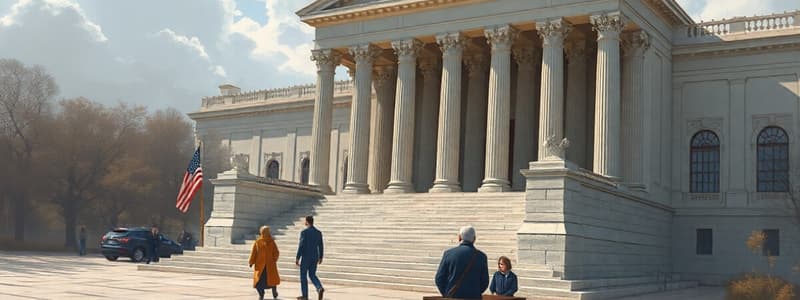Podcast
Questions and Answers
What is the primary purpose of the Supreme Court of the United States?
What is the primary purpose of the Supreme Court of the United States?
- To create new laws
- To conduct criminal trials
- To be the final court of appeal (correct)
- To enforce state laws
Which of the following models of judicial interpretation views the Constitution as a living document?
Which of the following models of judicial interpretation views the Constitution as a living document?
- Textualism
- Intentionalism
- Living Document (correct)
- Originalism
What is a key aspect of the process for the Supreme Court to hear a case?
What is a key aspect of the process for the Supreme Court to hear a case?
- Filing of a writ of certiorari (correct)
- Public trial hearings
- Direct constitutional amendments
- A unanimous vote from all justices
What is NOT a component of civil liberties as outlined by the Bill of Rights?
What is NOT a component of civil liberties as outlined by the Bill of Rights?
Which term describes a situation where bureaucratic agencies benefit specific interest groups, often at the public's expense?
Which term describes a situation where bureaucratic agencies benefit specific interest groups, often at the public's expense?
What aspect of political parties is mainly responsible for recruiting candidates for elections?
What aspect of political parties is mainly responsible for recruiting candidates for elections?
Which of the following is a distinguishing feature of Political Action Committees (PACs)?
Which of the following is a distinguishing feature of Political Action Committees (PACs)?
In which Supreme Court case was it established that independent expenditures by corporations can not be limited?
In which Supreme Court case was it established that independent expenditures by corporations can not be limited?
What does the Fairness Doctrine relate to?
What does the Fairness Doctrine relate to?
Which amendment ensures the right to vote shall not be denied based on race?
Which amendment ensures the right to vote shall not be denied based on race?
What is a characteristic of partisan gerrymandering?
What is a characteristic of partisan gerrymandering?
What is one consequence of the Voting Rights Act of 1965?
What is one consequence of the Voting Rights Act of 1965?
What impact does social desirability bias have on survey results?
What impact does social desirability bias have on survey results?
What is a typical feature of closed primary elections?
What is a typical feature of closed primary elections?
What is the purpose of early voting?
What is the purpose of early voting?
Which type of sampling is considered a non-random method?
Which type of sampling is considered a non-random method?
Flashcards
Yellow Journalism
Yellow Journalism
A style of journalism that emphasizes sensationalism and exaggeration to attract readers.
Fairness Doctrine
Fairness Doctrine
A former FCC policy requiring broadcasters to present differing viewpoints on important issues.
Culture of Objectivity
Culture of Objectivity
The expectation that news reporting should be unbiased and neutral.
Telecommunications Act of 1996
Telecommunications Act of 1996
Signup and view all the flashcards
Ideological Bias
Ideological Bias
Signup and view all the flashcards
Gatekeeping Bias
Gatekeeping Bias
Signup and view all the flashcards
Coverage Bias
Coverage Bias
Signup and view all the flashcards
Disinformation
Disinformation
Signup and view all the flashcards
Australian Ballot
Australian Ballot
Signup and view all the flashcards
Split-ticket Voting
Split-ticket Voting
Signup and view all the flashcards
Primary Elections
Primary Elections
Signup and view all the flashcards
Closed Primary
Closed Primary
Signup and view all the flashcards
15th Amendment
15th Amendment
Signup and view all the flashcards
19th Amendment
19th Amendment
Signup and view all the flashcards
Judicial Federalism
Judicial Federalism
Signup and view all the flashcards
SCOTUS
SCOTUS
Signup and view all the flashcards
Judicial Review
Judicial Review
Signup and view all the flashcards
Stare Decisis
Stare Decisis
Signup and view all the flashcards
Writ of Certiorari
Writ of Certiorari
Signup and view all the flashcards
Rule of Four
Rule of Four
Signup and view all the flashcards
Petition for Certiorari
Petition for Certiorari
Signup and view all the flashcards
Civil Liberties
Civil Liberties
Signup and view all the flashcards
Civil Rights
Civil Rights
Signup and view all the flashcards
Incorporation
Incorporation
Signup and view all the flashcards
Bureaucratic Capture
Bureaucratic Capture
Signup and view all the flashcards
Iron Triangle
Iron Triangle
Signup and view all the flashcards
Divided Government
Divided Government
Signup and view all the flashcards
Political Parties
Political Parties
Signup and view all the flashcards
Duverger's Law
Duverger's Law
Signup and view all the flashcards
Interest Groups
Interest Groups
Signup and view all the flashcards
PACs
PACs
Signup and view all the flashcards
Study Notes
Judicial Federalism
- Federal courts vs. state courts
- Structure of the court system
- Judiciary Act of 1789
- SCOTUS (Supreme Court of the US) purposes: final appeals court, judicial review (defining laws), stare decisis (precedent), writs of certiorari (orders lower courts to send up cases), rule of four
- SCOTUS process: petition for review, conference vote, decision, briefs filed, oral arguments (public), conference meeting (private), majority vote decision, majority opinion, dissenting and concurring opinions
- Methods for appointing justices
- Political limits on the court
- Models of judicial decision-making (textualism, intentionalism, living document, originalism)
- Civil rights vs. civil liberties
- Civil liberties: Bill of Rights, due process, habeas corpus, Bill of Attainder, ex post facto laws, impairment of contracts
- Civil rights: Reconstruction Amendments (13th, 14th, 15th)
Bureaucracy
- Bureaucracy, bureaucratic capture, iron triangle, revolving door
- Mandatory vs. discretionary federal spending (defense, social security, Medicare, Medicaid, etc.)
Political Parties
- Political parties (national, Hill, state, local)
- Functions of political parties (recruiting candidates, campaigning, governing, opposing)
- Political party organization (recruiting candidates, campaigning, governing, opposing)
- No mention of parties in the US Constitution
- Duverger's Law (single-member district vs. multi-member district; plurality voting)
Interest Groups
- Economic interests (corporations, businesses, labor)
- Citizen's groups (public interest groups, single-issue groups, ideological groups, demographic groups)
- Government interests
- Similarities and differences to political parties
- Interest group strategies (lobbying, donating, going public, litigation, protesting)
- PACs (Political Action Committees) and Super PACs
- Citizen's United v. FEC (2010)
- Hard money vs. soft money (campaign contributions)
Mass Media
- Mass media (forms, roles)
- Framing and priming
- Partisan vs. independent press
- Yellow journalism, muckraking
- Fairness doctrine
- Culture of objectivity
- Telecommunications Act of 1996 (media consolidation)
- Types of bias (ideological, gatekeeping, coverage)
- Disinformation and fake news
Voting
- Australian ballot vs. party ballots
- Split ticket voting
- Primary elections (closed, open, top two)
- Caucuses
- Amendments concerning voting
- 15th: right to vote regardless of race
- 19th: right to vote regardless of sex
- Voting restrictions (grandfather clauses, literacy tests, poll taxes, white primaries, voter intimidation)
- Voting Rights Act of 1965 (preclearance, coverage formula, backlash)
- Shelby County v. Holder (2013)
- Voting reforms increasing access (early voting, same-day registration, vote by mail, automatic registration, youth preregistration, online registration)
- Gerrymandering
- Districts drawn, state legislatures (or independent commissions)
- Reapportionment
- Apportionment Act of 1842
- Partisan and racial gerrymandering (cracking, packing, hijacking, kidnapping)
Public Opinion & Survey Methods
- Public opinion sampling (population vs. sample, inference)
- Non-random sampling (quota sampling)
- Random/probability sampling
- Issues with surveys/polls (social desirability bias, sampling bias, pros/cons of telephone vs. internet surveys)
Survey Design
- Single-sided question vs. two-sided question
- Close-ended vs. open-ended questions
- Double-barreled questions; ambiguous questions; leading questions
- Response rates, margin of error, polling averages
Studying That Suits You
Use AI to generate personalized quizzes and flashcards to suit your learning preferences.




